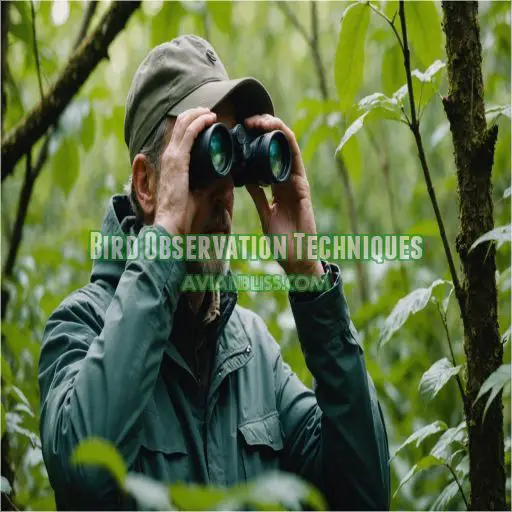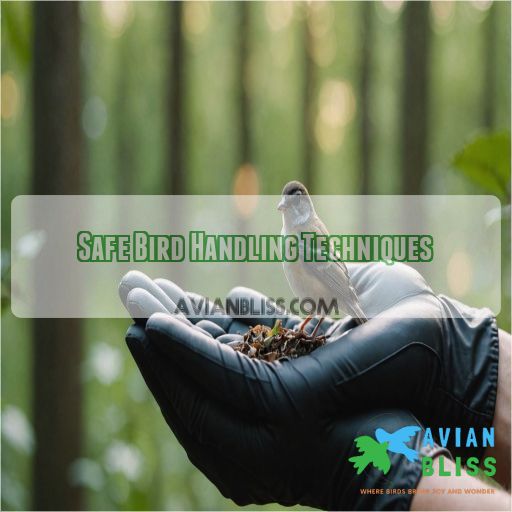This site is supported by our readers. We may earn a commission, at no cost to you, if you purchase through links.
 Sneaking up on birds is an art form, my friend. First, ditch the bright colors and opt for muted tones that blend into the environment. Then, move slowly and deliberately, avoiding sudden movements that could startle your feathered targets. Try a zigzag approach to keep them guessing. And don’t forget to use your car as a mobile blind – birds are less likely to flee from a stationary vehicle.
Sneaking up on birds is an art form, my friend. First, ditch the bright colors and opt for muted tones that blend into the environment. Then, move slowly and deliberately, avoiding sudden movements that could startle your feathered targets. Try a zigzag approach to keep them guessing. And don’t forget to use your car as a mobile blind – birds are less likely to flee from a stationary vehicle.
With a little practice, you’ll be observing birds up close without them even knowing you’re there. Just remember to respect their space and never make direct eye contact. Now, let’s explore some more advanced tips to take your birdwatching to new heights!
Table Of Contents
- Key Takeaways
- Getting Closer to Birds
- How to Sneak Up on Birds
- Creating a Bird-Friendly Environment
- Understanding Bird Behavior
- Bird Observation Techniques
- Attracting Birds to Your Home
- Safe Bird Handling Techniques
- Frequently Asked Questions (FAQs)
- How do you get a bird to come up to you?
- How do you appear non threatening to a bird?
- How to sneak up on birds skyward sword?
- How do you show a bird you’re not a threat?
- How can bird calls help locate birds?
- Which birds are most active at dusk?
- How does weather affect bird visibility?
- What colors do birds avoid?
- How to identify bird tracks in nature?
- Conclusion
Key Takeaways
- Dress the part by wearing muted, earth-toned clothing that helps you blend seamlessly into your surroundings, much like a sneaky tree in the forest.
- Move slowly and deliberately, using a zigzag approach to keep those feathered friends guessing – you’re like a gentle breeze, not a rumbling freight train.
- Use your car as a mobile blind to get up close and personal with birds without startling them; just remember to keep things quiet and avoid sudden movements.
- Create a bird-friendly oasis in your own backyard by planting native trees and shrubs, setting up feeders and baths, and establishing a cozy observation spot – your feathered friends will be flocking to your VIP birding retreat in no time.
Getting Closer to Birds
Want to get closer to birds and observe them up close?
With a few simple techniques, you can sneak up on your feathered friends without startling them.
From moving slowly to using camouflage, these expert tips will help you seamlessly blend into the environment and enjoy uninterrupted birdwatching.
Move Slowly and Carefully to Avoid Startling Birds
Mastering the art of moving slowly is your ticket to a successful birdwatching adventure.
Picture yourself as a leaf gently caught in the wind—graceful and inconspicuous.
This stealthy approach helps you slip under the radar while observing bird behavior.
By minimizing noise, you gain bird trust, letting their natural behavior—unhindered by bird fear—unfold beautifully before you.
Wear Drab Clothing to Blend in With the Environment
As you tiptoe through nature’s theater, your drab clothing acts as your camouflage, disguising you as a whisper in the wind.
Picture yourself as a tree among trees or a shadow that sashays silently.
Forget fluorescent fashion! Opt for muted tones that don’t scream, "Look at me!"
This subtle bird-watching attire helps you blend in, enhancing your nature observation and bird photography.
Respect Bird Space and Watch for Signs of Discomfort
Wearing drab clothing is just the start; respecting bird space is where the magic happens. Pay attention to bird body language and signs of distress. Crowding birds is a no-no; watch from a safe distance and enjoy ethical observation.
Approaching birds should be done with caution:
- Approach at an angle
- Avoid direct eye contact
- Freeze if a bird appears wary
- Know when to back off
Use a Photography Blind to Conceal Yourself
Photography blinds allow you to enter the birds’ world without disturbing them.
Pop-up tent blinds offer comfort and concealment, while ultraportable body blinds fit right over you and your gear.
Position your blind near food, water, or migratory pathways to maximize your chances of capturing stunning bird photos.
Just remember to move slowly and avoid direct eye contact – the birds will soon forget you’re there.
How to Sneak Up on Birds

Want to get closer to birds without causing a flutter? Try zigzag walking and avoid direct eye contact; it’s like playing hide and seek with nature’s finest (Source).
Zigzag Walking to Avoid Direct Approach
Master the art of bird watching by zigzagging toward your feathered friends.
Direct approaches can send them flying for the hills!
Like a sneaky detective, walk in a zigzag pattern to keep your intentions mysterious.
This quirky method respects bird behavior but also reduces the risk of startling them.
Remember: subtlety is your ally in bird photography.
Use a Car as a Mobile Blind for Concealment
Using a car as a mobile blind lets you watch birds without spooking them. Think of it as a cozy birdwatching haven:
- Park near bird hotspots.
- Roll down windows for unobstructed views.
- Cover reflective surfaces to avoid startling birds.
- Maintain silence; no loud music or horn honking.
Keep calm, enjoy bird antics, and savor the moment!
Avoid Eye Contact and Sudden Movements
Avoid making direct eye contact with birds – they’ll see you as a threat.
Instead, look slightly to the side or down.
And take it slow – sudden movements can startle them.
Move at a snail’s pace, pausing frequently to let birds adjust to your presence.
With patience, you’ll be rewarded with up-close encounters.
Creating a Bird-Friendly Environment
To create a bird-friendly environment, start by planting native trees and shrubs, which act as a fantastic buffet and shelter for your avian visitors.
Set up bird feeders and baths that’ll make your backyard feel like a luxury spa for birds, while you sketch them in comfort from your strategically placed observation spot using a sturdy bird feeder pole.
Plant Native Trees and Shrubs for Food and Shelter
Planting native trees and shrubs is like sending birds an open invitation to feel at home in your backyard.
By doing so, you create a bustling bird-friendly environment.
Native plant benefits include natural food sources and shelter, drawing in native birds while enhancing your landscape’s charm.
Your backyard habitat becomes a haven, where you can attract delightful winged visitors.
Use Bird Feeders and Baths to Attract Birds
Just like setting a fine dining table, you can enhance your bird-friendly haven by using different bird feeder types and an elegant bird bath design.
Choose the best birdseed to attract specific birds, and place feeders strategically.
It’s like setting up a VIP buffet! Watch your yard turn into a bustling avian hangout, complete with feathered guests aplenty.
Create a Comfortable Sketching Station in Your Backyard
Your backyard can become a bird-watching oasis!
Set up a cozy sketching station near your feeders and baths – a comfy chair, sketchpad, and pencils within reach.
As the birds flock to your yard, you’ll have a front-row seat to capture their beauty on paper.
Just remember to move slowly and let the birds acclimate to your presence.
Understanding Bird Behavior
To truly master birdwatching, you’ll want to understand that birds have flight paths even a novice air traffic controller would envy, darting up at the slightest hint of trouble.
They’re also quite the interior decorators, always seeking light-filled spots while shunning dark corners where they just can’t see the day.
Birds Typically Fly Upwards When Startled
In your backyard bird sanctuary, you’ll observe intriguing bird defense mechanisms.
When startled, birds typically fly upwards, like acrobats escaping a trampoline! This flight pattern is their startle response, a key part of bird safety.
So, keep sudden movements to a minimum to avoid an unexpected bird ballet. Understanding bird behavior helps you master these graceful interactions, creating a harmonious, bustling sanctuary.
Birds Gravitate Towards Light Sources and Avoid Dark Areas
Imagine birds at a disco, always gravitating toward the spotlight. They instinctively seek light, steering clear of dark areas like they’re allergic to shadows.
Observing this behavior can help you predict their movement. So, when you’re birdwatching, find brightly lit spots to catch a glimpse of them where they’re most comfortable, and avoid lurking in darkened areas!
Birds Seek High, Safe Places to Roost at Night
As night falls, birds seek out high, sheltered spots to roost safely.
Look for them perching on tree branches, ledges, or even gutters – anywhere that offers protection from predators and the elements.
By understanding this natural behavior, you can better anticipate where to spot birds during your evening outings.
Bird Observation Techniques
Having cracked the code of bird behavior, let’s explore observation techniques that make birdwatching a hoot! First up, find a "sit spot" where you can blend in like a secret agent. Patience is your best friend here; once birds forget you’re there, magic happens!
Keep field guides handy to identify feathered friends like those found in Maine. Listen for bird calls; they’re nature’s audio guide to the action.
When using a camera, tweak your camera settings for great shots without getting too close. Try setting a faster shutter speed to capture a bird’s sudden movements or go manual for creative flair.
Attracting Birds to Your Home
To turn your backyard into a bird paradise, make it irresistible with inventive food offerings and native plants.
You’ll have birds feeling like VIP guests, all while you get the perfect view from a discreetly placed photography blind or tent.
Use Inventive Food and Feeder Offerings to Attract Birds
To attract birds to your yard, try using different food and feeder types like a mix of black oil sunflower seeds, striped sunflower seeds, and safflower seeds.
Experiment with enticing blends like nutty seed mixtures or sweet hummingbird nectar.
- Feeder Placement: Position feeders where birds feel safe.
- DIY Feeders: Recycle materials for a fun, crafty touch.
- Hummingbird Feeders: Offer a sugar-water mix for energetic guests.
Birds will flock to your clever buffet!
Create a Bird-Friendly Yard With Native Plants and Shrubs
By planting native trees, shrubs, and flowers in your yard, you’ll create a lush, bird-friendly oasis.
These natural elements provide essential food, shelter, and nesting sites that birds crave.
Strategically place bird feeders and baths near dense foliage to offer sustenance while keeping feathered friends safe from predators.
Your backyard will soon become a vibrant avian haven.
Use a Photography Blind or Tent to Conceal Yourself
Using a photography blind is like being a stealthy ninja in the birding world.
With types of blinds available, you’ll blend perfectly with nature when bird-watching.
Camouflage tips include choosing best blind locations—for example, near feeders or shrubs.
Pay attention to bird reactions; soon they’ll accept your setup, giving you front-row seats to the feathered drama.
Safe Bird Handling Techniques
It’s important to remember that birds aren’t action figures but delicate creatures that deserve gentle care.
Use a two-handed grip for medium-sized birds or a one-handed grip or net for the smaller ones, and always handle them with caution to avoid injury.
Use a Two-Handed Grip for Medium-Sized Birds
While attracting birds to your yard, sometimes you might need to handle them safely.
For medium-sized birds, like a robin or a dove, use a two-handed grip that’s firm yet gentle. Imagine cradling an egg—not too tight, or you’ll omelet. This helps keep both the bird and your fingers safe from surprises or sudden flutters.
Use a One-Handed Grip or Net for Small Birds
For smaller birds, a one-handed grip or net is often the way to go.
Gently cup the bird in your palm, supporting its body and avoiding any tight holds.
If using a net, be mindful not to trap the bird’s wings.
With a light touch and steady movements, you can safely handle even the tiniest feathered friends.
Handle Birds Gently and Carefully to Avoid Injury
You’ve become a bird whisperer, expertly gripping small birds. Now it’s time to master handling them gently to avoid any feathered mishaps. Here’s how you can be their ultimate hero:
- Use Soft Hands: Imagine you’re holding marshmallows.
- Support Their Body: Like cradling a fragile ornament.
- Calm Their Fears: Whisper sweet nothings, no bird minds!
Avoid Handling Birds Unless Necessary, and Use Caution
Oh, friend, unless absolutely necessary, keep your hands to yourself! Handling birds is no walk in the park—with risks like bird diseases and stress, it’s as tricky as juggling porcupines! Respect bird safety by observing from a distance. Only intervene if a bird’s in danger. Remember, ethical concerns fly high; so, let’s keep those feathery friendships strictly hands-off!
Frequently Asked Questions (FAQs)
How do you get a bird to come up to you?
Ironically, the best way to get a bird to approach is to sit still and become a tree yourself.
Choose a spot near food or water, remain motionless, and let their curiosity bring them to you.
How do you appear non threatening to a bird?
To appear non-threatening to a bird, avoid direct eye contact and use zigzag movements.
Approach at a slight angle, staying low and still.
Think like a gentle breeze, not a rumbling train, and patience‘s your best companion.
How to sneak up on birds skyward sword?
Sneaking up on birds is a tricky game, but with a few bird-watching tricks up your sleeve, you can get up close and personal without ruffling any feathers.
Tread lightly, move slowly, and let the birds come to you.
How do you show a bird you’re not a threat?
Show a bird you’re harmless by doing the "I’m just a slow-moving tree" dance: walk in zigzags, avoid eye contact, and pause occasionally.
Like convincing your cat you’re not holding the dreaded bath towel—it’s all subtlety!
How can bird calls help locate birds?
Bird calls are like nature’s GPS for bird watchers.
By tuning into these melodic signals, you can pinpoint the location of various species.
It’s like bird karaoke—know the tunes, find the singers.
Which birds are most active at dusk?
As the sun dips below the horizon, owls and nighthawks emerge like shadowy phantoms, ready to hunt.
Keep your eyes peeled, your curiosity piqued, and you might just spot these masterful nocturnal hunters beginning their evening prowl.
How does weather affect bird visibility?
Cloudy, rainy, or foggy weather can make birds harder to spot, as they tend to stay more hidden and less active.
But you can still catch glimpses if you move slowly and keep an eye out for any movement or flashes of color.
What colors do birds avoid?
Some shades give birds the heebie-jeebies; they’re less enamored with loud, flashy colors like bright whites and neon hues.
Try to harmonize with nature instead by wearing earth tones, ensuring you don’t ruffle any feathers.
How to identify bird tracks in nature?
Identifying bird tracks feels like unraveling nature’s mystery.
Look for distinct three-toed patterns with a backward-facing toe in mud or sand.
Measure track sizes; note details like webbing or claw marks.
Bring binoculars to spot nearby avian culprits!
Conclusion
To master how to sneak up on birds, picture yourself as a tree, rooted yet ever so slightly swaying.
Stay patient and adaptable, respecting both the space and habits of your winged subjects.
Blend into their world with muted attire, a zigzag gait, and subtle movements.
Use your car as a concealment tool, and remember, a bird-friendly environment beckons them closer.
With practice, your birdwatching success will soar to new heights, creating memorable moments you won’t forget.









